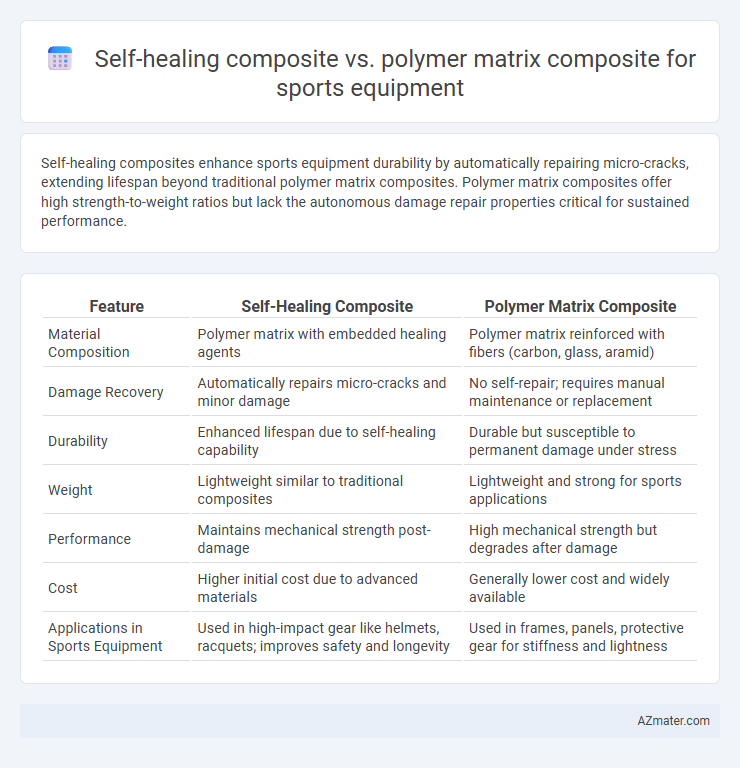Self-healing composites enhance sports equipment durability by automatically repairing micro-cracks, extending lifespan beyond traditional polymer matrix composites. Polymer matrix composites offer high strength-to-weight ratios but lack the autonomous damage repair properties critical for sustained performance.
Table of Comparison
| Feature | Self-Healing Composite | Polymer Matrix Composite |
|---|---|---|
| Material Composition | Polymer matrix with embedded healing agents | Polymer matrix reinforced with fibers (carbon, glass, aramid) |
| Damage Recovery | Automatically repairs micro-cracks and minor damage | No self-repair; requires manual maintenance or replacement |
| Durability | Enhanced lifespan due to self-healing capability | Durable but susceptible to permanent damage under stress |
| Weight | Lightweight similar to traditional composites | Lightweight and strong for sports applications |
| Performance | Maintains mechanical strength post-damage | High mechanical strength but degrades after damage |
| Cost | Higher initial cost due to advanced materials | Generally lower cost and widely available |
| Applications in Sports Equipment | Used in high-impact gear like helmets, racquets; improves safety and longevity | Used in frames, panels, protective gear for stiffness and lightness |
Introduction to Advanced Composites in Sports Equipment
Self-healing composites offer innovative advantages for sports equipment by autonomously repairing micro-cracks, enhancing durability and extending the lifespan of gear compared to traditional polymer matrix composites. Polymer matrix composites, widely used in high-performance sports applications, provide excellent strength-to-weight ratios but lack intrinsic self-repair capabilities, making them susceptible to cumulative damage under repeated stress. Advances in self-healing composite technology integrate microcapsules or vascular networks within polymer matrices, creating smart materials that maintain mechanical integrity and safety without frequent replacements or maintenance.
Overview of Polymer Matrix Composites (PMCs)
Polymer Matrix Composites (PMCs) consist of a polymer resin reinforced with fibers such as carbon or glass, providing high strength-to-weight ratios essential for sports equipment like tennis rackets and bicycle frames. The polymer matrix binds the fibers, distributing loads and enhancing impact resistance, while maintaining lightweight and flexibility crucial for athletic performance. Recent advancements focus on improving durability and damage tolerance, positioning PMCs as a versatile choice in optimizing sports gear performance and safety.
Emergence of Self-Healing Composites
Self-healing composites are revolutionizing sports equipment by integrating microcapsules or vascular networks that autonomously repair damage, enhancing durability and lifespan beyond traditional polymer matrix composites. These advanced materials address microcracks and stress fractures in real-time, reducing maintenance and improving performance under dynamic loads typical in sports applications. Emerging self-healing technology offers a significant competitive advantage by combining lightweight polymer matrix benefits with extended functionality and resilience.
Material Properties Comparison: Self-Healing vs Polymer Matrix Composites
Self-healing composites in sports equipment offer enhanced durability by autonomously repairing micro-cracks, extending the lifespan compared to traditional polymer matrix composites (PMCs) which lack this intrinsic repair capability. While PMCs typically provide excellent strength-to-weight ratios and resistance to impact, self-healing composites improve damage tolerance through embedded healing agents or microvascular networks. The advanced material properties of self-healing composites lead to reduced maintenance, improved safety, and consistent performance under repetitive stress conditions common in high-impact sports.
Performance Enhancement in Sports Gear
Self-healing composites in sports equipment offer enhanced durability by autonomously repairing micro-cracks, significantly extending the lifespan of gear compared to traditional polymer matrix composites. Their ability to maintain structural integrity under repetitive stress improves performance consistency and athlete safety in high-impact sports. Polymer matrix composites remain popular due to their lightweight and customizable mechanical properties, but self-healing technology provides a competitive edge by reducing maintenance costs and downtime.
Durability and Longevity Factors
Self-healing composites significantly enhance the durability and longevity of sports equipment by autonomously repairing micro-cracks and damage, reducing maintenance needs and prolonging the lifespan compared to traditional polymer matrix composites. Polymer matrix composites, while lightweight and strong, lack intrinsic repair mechanisms, leading to cumulative structural degradation under repetitive stress and impact. The integration of self-healing agents in composite materials addresses fatigue failure and environmental wear, making them superior for high-performance sports gear requiring sustained reliability.
Impact on Maintenance and Repair Costs
Self-healing composites in sports equipment significantly reduce maintenance and repair costs by autonomously repairing minor damages, extending the lifespan of the gear. Polymer matrix composites, while strong and lightweight, often require manual inspection and professional repair when damaged, leading to higher downtime and expense. The integration of microcapsules or vascular networks in self-healing materials optimizes durability, ultimately minimizing long-term operational costs for athletes and sports teams.
Weight and Flexibility Considerations
Self-healing composites in sports equipment offer enhanced durability by autonomously repairing micro-cracks, contributing to longer lifespan without significant weight increase compared to traditional polymer matrix composites, which typically provide a lighter structure but lack self-repair capabilities. Polymer matrix composites are engineered for optimal flexibility and lightweight performance, crucial for high-mobility sports gear, whereas self-healing composites tend to incorporate additional healing agents that may slightly increase weight and reduce flexibility. Balancing the trade-off between self-healing functionality and mechanical properties is key for manufacturers aiming to improve sports equipment resilience while maintaining athlete performance through effective weight and flexibility optimization.
Environmental Impact and Sustainability
Self-healing composites in sports equipment enhance durability by autonomously repairing damage, reducing the frequency of replacements and waste compared to traditional polymer matrix composites. The intrinsic repair mechanism extends product lifespan, lowering environmental impact through decreased material consumption and landfill accumulation. Polymer matrix composites, while lightweight and high-performance, often rely on non-biodegradable resins that contribute to environmental pollution and pose challenges in recycling and end-of-life disposal.
Future Trends and Innovations in Sports Composites
Self-healing composites are revolutionizing sports equipment by enhancing durability and extending product lifespan through microcapsule or vascular network technologies that repair damage autonomously. Polymer matrix composites (PMCs) maintain popularity due to their lightweight and high-strength properties but face limitations in damage tolerance without external repair. Future innovations will likely blend self-healing capabilities with advanced PMC formulations, integrating nanomaterials and smart sensors to create adaptive, high-performance gear tailored for athlete safety and real-time condition monitoring.

Infographic: Self-healing composite vs Polymer matrix composite for Sports equipment
 azmater.com
azmater.com